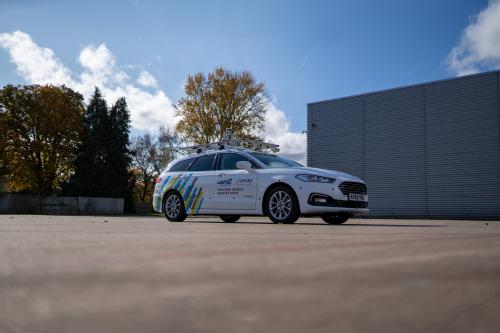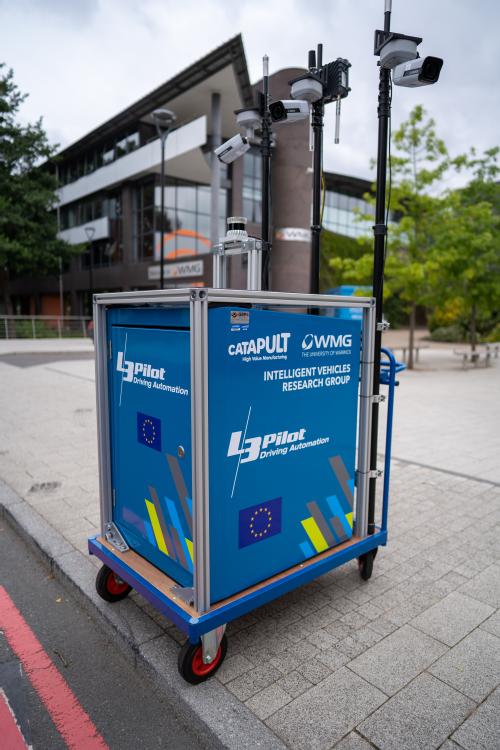Success Story
WMG creates novel open innovation vehicle platform to support the development and testing of Connected and Autonomous Vehicles products and services
Challenge and Opportunity
By 2035, the Connected and Autonomous Vehicles (CAV) and CAV technologies markets are projected to be worth £650bn globally and £41.7bn in the UK. Developing high capabilities and competitiveness in the production of CAV technologies will give the UK the opportunity to both decrease import shares and increase export shares within relevant markets by up to 50% (against baseline assumptions) – leading to an increase in gross output, GVA and jobs.[1]
To maintain momentum in this area, it is critical that UK industry has access to specialist equipment and people to easily develop, test, and demonstrate products and services, as well as bring them to market.

Solution
With support from the High Value Manufacturing Catapult (HVMC), WMG has developed a vehicle test and evaluation platform to do just this. The Open Innovation Vehicle Platform (OIVP) is an open, modular, and autonomous capable solution complimented by two Mobile Roadside Units (MRSU). It provides an ideal opportunity to accelerate the commercialisation of Connected, Cooperative and Automated Mobility (CCAM) products and services. Both the OIVP and MRSUs are designed to work together during operation, with the MRSU able to act as a temporary roadside infrastructure node to collect and share local perception data in real time to nearby connected vehicles. They provide a highly flexible and open testing platform for the rapid development of novel ideas for UK businesses, particularly SMEs, as well as research organisations and transport authorities.
Impact
A range of industrial and research partners have now started to make use of the platform and roadside units securing >£3.4m in collaborative R&D (CR&D) funding and >£400k in direct contract research (DCR). Highlights have included three recent projects, all focusing on the use of additional information from roadside infrastructure to support driving more safely and efficiently:
- EU L3Pilot (34 partners across 10 countries, including automotive manufacturers such as Volkswagen AG, SMEs, research bodies and government authorities): The MRSU was used to support the OIVP to drive autonomously through a T-Junction even when the view from the ego vehicle was blocked by a parked vehicle.
- EPSRC CARMA (WMG, Jaguar Land Rover, TRL and the University of Surrey): The OIVP was used to demonstrate the benefits provided by the novel three-tier processing CARMA platform. The OIVP was able to optimise its route through a connected roundabout by making use of perception data shared by the infrastructure.
- Innovate UK Autoplex (WMG, Jaguar Land Rover, Highways England, Yunex Traffic, Transport for West Midlands): The OIVP was used to demonstrate how a connected vehicle can make use of infrastructure RADAR sensor data to merge safely and comfortably on a UK public motorway.

Catapult funding has also supported the training and development of five graduate engineers, three of whom have now progressed into WMG Project Engineer roles as core members of the team that operate the OIVP and MRSUs. The project has also supported several PhD / EngD, MSc and undergraduate projects. There is currently an EngD project sponsored by MOLE to develop an automated park function to integrate with a robotic autonomous wired charger.
The platforms and the knowledge developed by the team will also be applied to other sectors such as very light rail, as well as automated guided vehicles used in manufacturing.
What’s Next?
WMG’s applied research is accelerating the development and commercialisation of CCAM solutions, helping to realise its promise of safer, faster, more efficient, and lower carbon transport.
Dr Graham Lee, Principal Engineer at WMG, University of Warwick, commented: “The team has created a highly capable vehicle platform that has already been used in several projects to tackle a variety of complex problems currently being faced by the industry. The MRSU is a unique piece of hardware that allows developers to rapidly test and evaluate novel technologies designed for roadside infrastructure. Both platforms and the knowledge and expertise of the team will enable industry partners to realise and bring to market innovative CCAM products and services.”
Professor Mehrdad Dianati, Head of Intelligent Vehicles Research at WMG, University of Warwick added: “As the transformation of future mobility systems accelerates, there are huge opportunities for the UK’s thriving SMEs, as well as more established businesses. The UK economy is well placed to flourish in knowledge-based sectors in emerging areas such as connected, automated, shared, and electrified future mobility systems and collaborative robotic systems. These facilities are powerful tools for collecting data, training Artificial Intelligence (AI)/Machine Learning (ML) models and testing emerging concepts in Cooperative Autonomy and Multi-Agent Systems, which are becoming increasingly promising technologies across multiple application sectors."
Key features of the OIVP and MRSU currently include:
Open Innovation Vehicle Platform (OIVP)
- Modular / plug-and-play hardware, enabling components to be integrated and positioned easily
- Sensor Suite: 360° camera, LiDAR and ultrasonic as well as forward and rear facing RADAR
- Connectivity: 4G/5G, WiFi, ITS-G5/DSRC and in-vehicle communication (CAN & ethernet)
- GNSS with Real-Time-Kinematic (RTK), providing centimetre level positioning accuracy
- Custom auxiliary battery power system, which can power the additional equipment for all day testing
- Drive-by-wire (DBW) system, which allows the vehicle’s speed, acceleration, steering angle and other parameters to be controlled via software
- Custom Autonomous Control System (ACS) with perception, localisation, planning and control functions
- On-board computing
Mobile Road Side Unit (MRSU)
- Modular / plug-and-play hardware
- Sensor Suite: LiDAR, RADAR, camera and weather sensors
- Connectivity: 4G/5G, WiFi and ITS-G5/DSRC
- Extendable poles up to 8m, to mount equipment at height
- Weatherproof with internal cooling and heating
- Custom battery power system
- On-board/Edge computing
For more information about working with these platforms and the team, email wmgbusiness@warwick.co.uk
[1] Connected Places Catapult (2020). Market Forecast for Connected and Autonomous Vehicles, pp 56.
